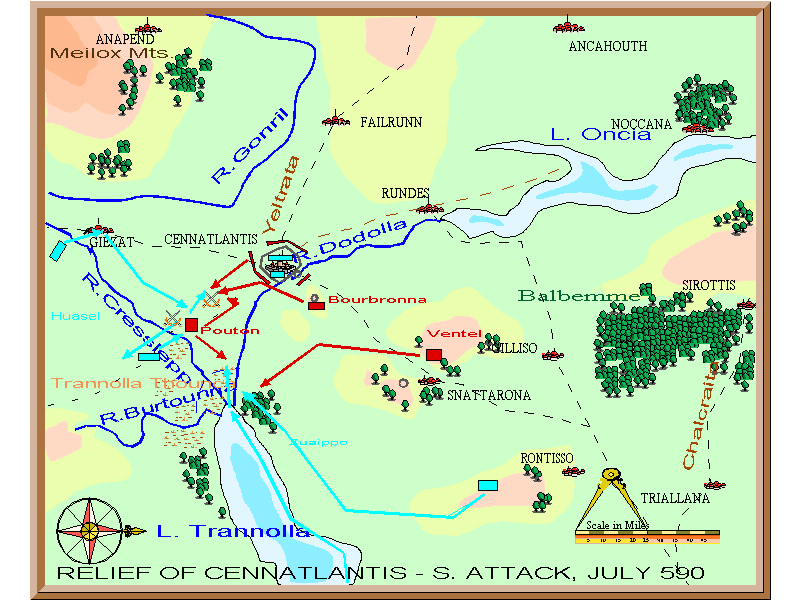|
Home Page
Discovery of Atlantis
First Empire-(1) to 261
Second Empire- (1) 361 - 409 |
|
THE ATTEMPT TO RELIEVE CENNATLANTIS FROM THE SOUTH,
JULY 590
During the summer months, the Republicans tried to create a naval presence on Lake Oncia, to rival the Imperialist control of the waters. The Imperialists in fact now planned to try to strike to the west of the river Dodolla, from the south, destroying the Republicans and relieving Cennatlantis, and took the opportunity of attracting the attention of the enemy northwards. They sent out their navy on to the middle of the Lake, which attracted the Republican fleet to it. It was partially defeated, and forced back to its port at Rundes. Meanwhile, General Huasel had concentrated most of his army (about 50000) south of the river Cresslepp, near Giezat, leaving 30000 near Rontisso under Gaivlin. The latter would act as a decoy, by threatening another attack down the northern edge of Lake Trannolla towards that end of the Dodolla, along with a naval force with 15000 men. The Imperialist operations began in mid-July, just after the Republican naval defeat on Lake Oncia had taken place. This had no influence on Bourbronna, who immediately realised that the Imperialist naval escapades were just a diversion. His spies had told him of the Imperialist forces on and north of Lake Trannolla, though he was not yet aware of any additional enemy troops south of the river Cresslepp. His forces were divided in three groups Ė 18000 under Ventel on the Snattarona heights; 20000 under his personal command on the hills east of Cennatlantis; and 22000 under Pouton south of Cennatlantis, between the Dodolla and Cresslepp. There was also a garrison in Rundes, and the besieging forces surrounding Cennatlantis. This time, it can be seen that the Imperialists had concentrated their forces much more thoroughly than in April, and had 35000 man opposite Giezat, 15000 further south along the Cresslepp, making 50000 in all facing Poutonís 22000.Pouton had only an observation force in Giezat, with most of his force to the south-east, opposite part of Huaselís army. He was also keeping an eye on Zuaippo who was moving down Lake Trannolla towards him, accompanied by a slow-moving naval force. The latter landed in the marshes between the Dodolla and Cresslepp on July 18th, while Zuiappo approached the Dodolla. None of this had gone unnoticed by Bourbronna, as Huasel intended, and Ventel was instructed to move off southwards and hit these enemy forces in flank. Thus Huasel was able to force his way over the river and into Giezat on July 22nd-23rd with little trouble. He now moved north-east on Poutonís flank, while the Imperialists opposite Pouton sought to hold him in position, by trying to cross the river. Pouton himself was split into various small forces, trying to observe and deal with all these stronger imperialist armies, and Bourbronna warned him repeatedly to keep his army concentrated. He decided by the 24th that the focus of activity was the other side of the Dodolla, and hastened to move his force over there, going south of Cennatlantis. The Imperialists now needed to move fast and decisively, before the Republicans could concentrate. Huasel, however, moved his army quite deliberately, and although he was able to inflict a couple of defeats on parts of Poutonís forces on July 25th-26th, he then halted. Pouton was desperately trying to concentrate his corps to the north, nearer to Cennatlantis, where he would be reinforced by Bourbronna himself. The two forces had joined up by July 27th, and as Huasel cautiously moved north on the 28th, Bourbronna and Pouton together, with 40000 man were able to attack Huaselís left flank in a decisive battle. Here as usual, the Republicans were able to deploy their swarm of fast-moving infantry OCHOSIX and cavalry to bewilder the slower-moving enemy, and then concentrate on a flank. Huasel, having lost contact anyway with Zuaippo, retreated back over the Cresslepp, hustled by the Republicans. To the east, Ventel had forced Zuaippo to retreat, while the Imperialist naval force in the Trannolla Thounca (marshes) could only sit and wait, unsupported by either Ventel or the retreating Huasel. It was soon hustled back on to its boats by Pouton. Thus ended the second unsuccessful attempt by the Imperialists to relieve the capital. Despite a better conceived plan, the Imperialists still moved too slowly, and were outwitted by Bourbronna, who was able to guess their intentions, and concentrate his forces to beat them, although even at the climactic battle, he only had 40000 against 48000 Imperialists. |
